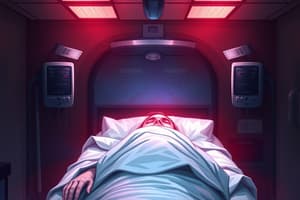Podcast
Questions and Answers
What is the primary characteristic of maceration in a fetus due to intrauterine death?
What is the primary characteristic of maceration in a fetus due to intrauterine death?
- It is a permanent state replacing putrefaction.
- It occurs only in the presence of bacteria.
- The fetus becomes brown, edematous, and flaccid. (correct)
- It results in a hard, waxy yellow material.
What distinguishes adipocere formation from putrefaction?
What distinguishes adipocere formation from putrefaction?
- Adipocere does not occur in submerged bodies.
- Adipocere can only form in dry conditions.
- Adipocere preserves facial features and is a waxy material. (correct)
- Adipocere is formed primarily in dry hot climates.
In which environment is mummification most likely to occur?
In which environment is mummification most likely to occur?
- In dry hot conditions. (correct)
- In enclosed areas with minimal air flow.
- In wet, humid environments.
- In cold, icy conditions.
How does the time required for adipocere formation differ from that of mummification?
How does the time required for adipocere formation differ from that of mummification?
Which postmortem change can be used to identify cause of death due to preservation of injury?
Which postmortem change can be used to identify cause of death due to preservation of injury?
What is one of the requirements for diagnosing clinical death related to brain function?
What is one of the requirements for diagnosing clinical death related to brain function?
Which mechanism of death involves infection leading to systemic issues?
Which mechanism of death involves infection leading to systemic issues?
In which condition do the higher cerebral powers of the brain cease, while brainstem functions remain intact?
In which condition do the higher cerebral powers of the brain cease, while brainstem functions remain intact?
What factor does NOT affect the rate of post mortem cooling (algor mortis)?
What factor does NOT affect the rate of post mortem cooling (algor mortis)?
Which of the following is NOT one of the categories of death manner?
Which of the following is NOT one of the categories of death manner?
What is a key feature of apnea used for diagnosing cessation of respiration?
What is a key feature of apnea used for diagnosing cessation of respiration?
Which type of cooling occurs due to the cessation of metabolic processes after death?
Which type of cooling occurs due to the cessation of metabolic processes after death?
Which response type indicates continued brainstem function in a brain-dead patient?
Which response type indicates continued brainstem function in a brain-dead patient?
What is the primary effect on the rate of cooling of clothed bodies compared to naked bodies in water?
What is the primary effect on the rate of cooling of clothed bodies compared to naked bodies in water?
Which change occurs immediately at the moment of death related to muscle tone?
Which change occurs immediately at the moment of death related to muscle tone?
What is the first noticeable change in the eyes after death?
What is the first noticeable change in the eyes after death?
What happens to the color of the skin due to the absence of circulation after death?
What happens to the color of the skin due to the absence of circulation after death?
When does postmortem lividity begin to become fixed?
When does postmortem lividity begin to become fixed?
What distinguishes the normal color of livor mortis?
What distinguishes the normal color of livor mortis?
What is the significance of the temperature of a body in cases of death caused by asphyxia?
What is the significance of the temperature of a body in cases of death caused by asphyxia?
What is the term for the brownish discoloration of exposed sclera observed after death?
What is the term for the brownish discoloration of exposed sclera observed after death?
What is the primary objective of a medico-legal autopsy?
What is the primary objective of a medico-legal autopsy?
Which type of death refers to the irreversible loss of basic bodily functions?
Which type of death refers to the irreversible loss of basic bodily functions?
What is the significance of molecular life in the context of organ transplantation?
What is the significance of molecular life in the context of organ transplantation?
Which of the following statements correctly defines the mechanism of death?
Which of the following statements correctly defines the mechanism of death?
What is an essential aspect of a forensic autopsy that distinguishes it from a clinical autopsy?
What is an essential aspect of a forensic autopsy that distinguishes it from a clinical autopsy?
What type of examinations are typically obtained during a forensic autopsy?
What type of examinations are typically obtained during a forensic autopsy?
What color of lividity is typically observed in carbon monoxide poisoning?
What color of lividity is typically observed in carbon monoxide poisoning?
At what point after death does lividity begin to appear?
At what point after death does lividity begin to appear?
Which statement about the objectives of forensic autopsy is incorrect?
Which statement about the objectives of forensic autopsy is incorrect?
Which statement about rigor mortis is correct?
Which statement about rigor mortis is correct?
Which of the following illustrates an example of physiological derangement as a cause of death?
Which of the following illustrates an example of physiological derangement as a cause of death?
What factor influences the extent of lividity observed postmortem?
What factor influences the extent of lividity observed postmortem?
How does the color of lividity in natural death differ from that in asphyxia?
How does the color of lividity in natural death differ from that in asphyxia?
What indicates the presence of postmortem hypostasis in the body?
What indicates the presence of postmortem hypostasis in the body?
What role does ATP play in the development of rigor mortis?
What role does ATP play in the development of rigor mortis?
Which of the following conditions is likely to lead to more pronounced lividity?
Which of the following conditions is likely to lead to more pronounced lividity?
Which factor does NOT enhance the rate of putrefaction?
Which factor does NOT enhance the rate of putrefaction?
What indicates prolonged putrefaction in a deceased individual?
What indicates prolonged putrefaction in a deceased individual?
Which condition is associated with rapid putrefaction?
Which condition is associated with rapid putrefaction?
Which of the following is a characteristic of putrefaction after two weeks in summer?
Which of the following is a characteristic of putrefaction after two weeks in summer?
Which type of decomposition occurs primarily in cases of intrauterine fetal death?
Which type of decomposition occurs primarily in cases of intrauterine fetal death?
What is a major factor inhibiting putrefaction in submerged bodies?
What is a major factor inhibiting putrefaction in submerged bodies?
How does temperature affect the process of putrefaction?
How does temperature affect the process of putrefaction?
Which statement accurately reflects the changes observed in a body after one year?
Which statement accurately reflects the changes observed in a body after one year?
Flashcards
Forensic Pathology
Forensic Pathology
The branch of medicine that combines medical knowledge with legal investigations, focusing on understanding causes of death and analyzing injuries.
Medico-legal Autopsy
Medico-legal Autopsy
The type of autopsy performed to determine the cause of death in cases involving legal inquiries, such as suspicious or violent deaths.
Clinical Autopsy
Clinical Autopsy
The type of autopsy performed to learn the extent of a patient's disease, often conducted with the consent of the family after a natural death.
Mechanism of Death
Mechanism of Death
Signup and view all the flashcards
Cause of Death
Cause of Death
Signup and view all the flashcards
Somatic Death
Somatic Death
Signup and view all the flashcards
Molecular Death
Molecular Death
Signup and view all the flashcards
Thanatology
Thanatology
Signup and view all the flashcards
Manner of death
Manner of death
Signup and view all the flashcards
Clinical death
Clinical death
Signup and view all the flashcards
Cessation of circulation
Cessation of circulation
Signup and view all the flashcards
Cessation of respiration
Cessation of respiration
Signup and view all the flashcards
Cessation of brain function
Cessation of brain function
Signup and view all the flashcards
Persistent Vegetative State (PVS)
Persistent Vegetative State (PVS)
Signup and view all the flashcards
Algor Mortis
Algor Mortis
Signup and view all the flashcards
Post-Mortem Cooling (Algor Mortis)
Post-Mortem Cooling (Algor Mortis)
Signup and view all the flashcards
Livor Mortis (Hypostasis)
Livor Mortis (Hypostasis)
Signup and view all the flashcards
Post-Mortem Lividity (Hypostasis)
Post-Mortem Lividity (Hypostasis)
Signup and view all the flashcards
Primary Flaccidity
Primary Flaccidity
Signup and view all the flashcards
Changes in the Eyes after Death
Changes in the Eyes after Death
Signup and view all the flashcards
Taches Noire
Taches Noire
Signup and view all the flashcards
Changes in the Skin After Death
Changes in the Skin After Death
Signup and view all the flashcards
Lividity
Lividity
Signup and view all the flashcards
Lividity Location
Lividity Location
Signup and view all the flashcards
Lividity: Time of Death
Lividity: Time of Death
Signup and view all the flashcards
Lividity: Cause of Death
Lividity: Cause of Death
Signup and view all the flashcards
Rigor Mortis Progression
Rigor Mortis Progression
Signup and view all the flashcards
Rigor Mortis: Time of Death
Rigor Mortis: Time of Death
Signup and view all the flashcards
Rigor Mortis Significance
Rigor Mortis Significance
Signup and view all the flashcards
Maceration (Fetal)
Maceration (Fetal)
Signup and view all the flashcards
Adipocere
Adipocere
Signup and view all the flashcards
Mummification
Mummification
Signup and view all the flashcards
Skeletalization
Skeletalization
Signup and view all the flashcards
Putrefaction
Putrefaction
Signup and view all the flashcards
Greenish Discoloration
Greenish Discoloration
Signup and view all the flashcards
Marbling
Marbling
Signup and view all the flashcards
Swelling and Protrusion
Swelling and Protrusion
Signup and view all the flashcards
Severe Putrefaction
Severe Putrefaction
Signup and view all the flashcards
Liquefaction of Soft Tissues
Liquefaction of Soft Tissues
Signup and view all the flashcards
Study Notes
Forensic Medicine
- Forensic pathology is a branch of medicine applying medical principles and knowledge to legal problems.
- It bridges the gap between medicine and law by applying medical knowledge to legal issues.
Types of Autopsy
- A clinical or academic autopsy is performed with the consent of relatives to determine the extent of disease that led to death.
- A medico-legal or forensic autopsy is performed by legal authority to investigate sudden, suspicious, obscure, unnatural, litigious, or criminal deaths.
Objectives of Forensic Autopsy
- Positive identification of the body, assessing body size, physique, and nourishment.
- Determining the cause of death, or in newborns, whether live birth occurred.
- Determining the mechanism and time of death, if necessary.
- Demonstrating all external and internal abnormalities, malformations, and diseases.
- Detecting, describing, and measuring external and internal injuries.
- Obtaining samples for analysis, including microbiological and histological examinations.
- Retaining relevant organs and tissues as evidence.
- Obtaining photographs and videos for evidentiary and teaching purposes.
- Providing a full written report of the autopsy findings.
- Offering expert interpretation of the findings.
- Restoring the body to the best possible cosmetic condition before release.
Thanatology (Death & Postmortem Changes)
Death and Postmortem Changes
- Somatic (clinical death) is the permanent cessation of the integrated functioning of an individual, associated with the irreversible loss of circulation, respiration, and central nervous system innervations.
- Molecular (cellular death) is the death of individual organs and tissues; cortical neurons die after 3-7 minutes, while skin and bone remain alive for several hours.
- Medico-legal importance: organs transplantation occurs during the period of molecular life.
Cause, Mechanism, and Manner of Death
- Cause of death is any injury or disease producing physiological derangement leading to death (e.g., hemorrhage, septicemia, cardiac arrhythmia, cardiopulmonary arrest).
- Mechanism of death is the physiological derangement produced by the cause of death.
- Manner of death describes how the cause of death occurred (e.g., accidental, homicidal, suicidal, natural, unidentified).
Diagnosis of Somatic (Clinical) Death
-
Cessation of Circulation:
- Loss of pulsations in major arteries (carotid and femoral).
- Absence of perceptible blood pressure.
- Loss of heartbeats (for 5 minutes).
- Flatline on all ECG leads (for 5 minutes).
-
Cessation of Respiration:
- Apnea (checked by careful auscultation).
- Severe hypoxia and hypercapnea (revealed by arterial blood gas analysis).
-
Cessation of Brain Function (brain death):
- Unresponsiveness to any stimulus (deep coma).
- Absence of motor responses (no response to painful stimuli).
- Absence of reflex responses indicative of continued brain stem function (absence of corneal reflex, absence of pupillary response to bright light).
- Absence of spontaneous eye movements or those in response to head turning (oculocephalic response).
- Absence of eye movement in response to ice water irrigation of the ear (oculovestibular response).
- Absence of gag reflex to a catheter placed in the larynx and trachea.
- Apnea (arterial PCO2 level exceeding 50 mm Hg).
-
Persistent Vegetative State (PVS): A patient loses higher-level brain function but retains brainstem functions (respiration and circulation) (e.g., massive cerebral infarcts, hypoxic encephalopathy, head trauma)
Postmortem (PM) Changes
-
PM Cooling (Algor Mortis):
- Stoppage of heat production due to cessation of oxidative processes and metabolism.
- Heat loss through conduction, convection, and radiation.
- Body temperature decreases by 1-1.5°C per hour.
-
Factors affecting the rate of cooling:
- Age (infants cool rapidly due to large surface area).
- Sex (females cool more slowly due to subcutaneous fat).
- Obesity (subcutaneous fat is a poor heat conductor).
- Environment (bodies in well-ventilated rooms cool faster than those in closed rooms; bodies in water cool twice as fast as bodies in air); (clothed bodies cool more slowly than naked bodies).
-
Primary Flaccidity (Contact Flattening):
- Complete muscle relaxation and loss of reflexes at death.
- Face assumes peaceful expression; jaw drops; pupils dilate.
- Muscle contraction due to electrical stimuli is absent.
- Convex muscle parts flatten against flat surfaces.
-
Change of the Eyes:
- Loss of corneal and light reflexes.
- Retinal vessel segmentation and optic disc pallor (visible within 15 minutes).
- Intraocular pressure drop leading to sunken and flaccid eyeballs (visible within 30 mins).
- Cloudy and opaque cornea (visible after 2 hours).
- Brownish discoloration (tache noire) of exposed sclera (visible within 3-4 hours), due to accumulation of cellular debris and dust.
-
Changes of the Skin: skin becomes pale and opaque due to absent circulation. Skin loses elasticity, so wounds do not gap.
-
PM Lividity (Hypostasis or Livor Mortis):
- Bluish discoloration and staining of the dependent parts of the body due to gravitational fluid blood and stagnation in capillaries and veins.
- Starts immediately after death due to cessation of circulation.
- Appears within one hour after death.
- Maximum and fixed in approximately 8 hours.
- Does not alter with body position changes.
- Colour (light blue to deep blue, red or brown): can vary based on cause of death.
-
MLI of Livor Mortis: (colour; extent ; site ) - It is a sure sign of death.
-
It denotes the time that has passed since death, starting to appear after 1 hour, and reaching maximum after 8 hours.
-
Its site indicates the position of the body during the first 8 hours after death.
-
PM Rigidity (Rigor Mortis):
- Progressive rigidity of voluntary and involuntary muscles following primary flaccidity and preceding secondary flaccidity.
- Full rigor mortis within 12 hours after death.
- Mechanism: depletion of ATP in muscle cells, leading to actin and myosin filament bonding.
- MLI of Rigor Mortis: is a sure sign of death. It denotes the time passed since death by its start, extent, and disappearance rate(starts in face and progresses downward).
- Factors that affect rigor mortis: temperature, cause of death, muscle mass, body weight.
- Differentiation from cold or heat stiffening or cadaveric spasm.
-
Secondary Flaccidity:
- Muscles become soft and flaccid after rigor mortis.
- Do not respond to mechanical or electrical stimuli.
- Autolysis of tissue proteins leads to this stage.
-
Putrefaction (PM Decomposition):
- Final stage of decomposition of soft tissues, leaving only bones.
- Mechanism:
- Autolysis: release of enzymes from tissue cells, leading to softening and liquefaction.
- Bacteria: aerobic and anaerobic bacteria break down tissues, produce gases, and cause various changes.
- MLI of Putrefaction: A sure sign of death
-
Effect of Putrefactive Gases:
- Expulsion of fetus from gravid uterus.
- Flotation of drowned bodies.
- Expulsion of feces and gastric contents.
- Protrusion of tongue and eyes with froth on mouth and nose.
-
Factors affecting Putrefaction
- Temperature
- Air
- Moisture
- Age
- Cause of death.
-
Conditions Replacing Putrefaction
- Maceration: intrauterine fetal death (aseptic autolysis), temporary state.
- Adipocere: in water or wet ground, greasy yellowish-grey wax-like material, caused by bacterial anaerobic oxidation of fats.
- Mummification: in desert climates (no water) dry condition (slow or stopped putrefaction), dehydrated body.
-
Skeletalization (Skeletonization): Final decomposition stage where only bones remain.
Studying That Suits You
Use AI to generate personalized quizzes and flashcards to suit your learning preferences.
Related Documents
Description
Test your knowledge on key concepts of postmortem changes, including maceration in fetuses, adipocere formation, mummification, and the preservation of injury. This quiz will challenge your understanding of the processes that occur after death and their implications in forensic science. Perfect for students and professionals interested in forensic pathology.




